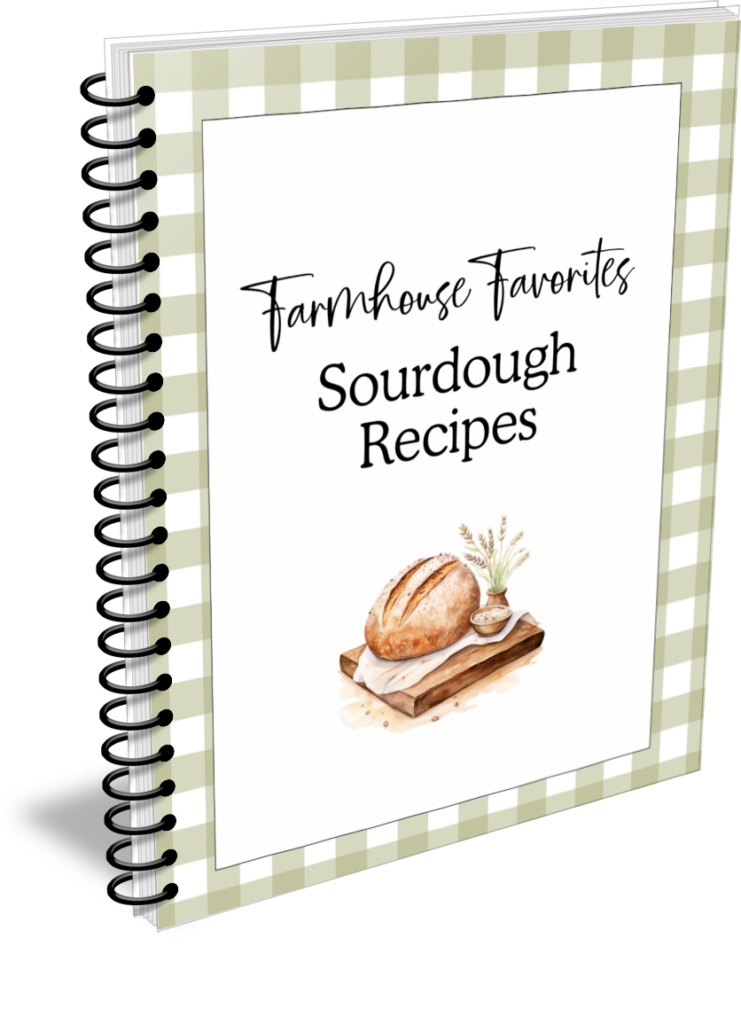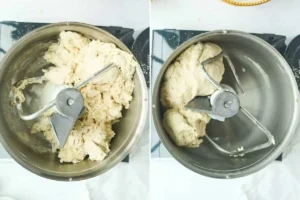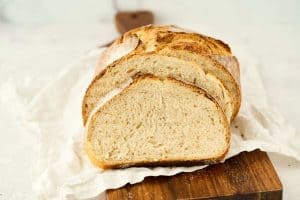Stand Mixer Sourdough Bread
Sure, you could stretch and fold all day long (and sometimes I do), but you absolutely do not have to. If you’ve always wanted to try sourdough but it seems weird and confusing and too hands-on, this stand mixer sourdough bread recipe is the answer. Just like a classic bread recipe, we knead, we shape, we rise, we bake. Simple!
It’s definitely one of those sourdough bread recipes you’ll turn to over and over.
Stand Mixer Sourdough Bread

Equipment
- Stand mixer (with dough hook attachment)
- Mixing Bowls
- Damp tea towel or clean kitchen towel
- Plastic Wrap
- Proofing baskets (or parchment-lined baking sheets)
- Lame or serrated knife
- cooling rack
Ingredients
- 6 cups bread flour (31.8 ounces)
- 2 cups lukewarm water (16 ounces)
- 1 ½ cups active sourdough starter (11.25 ounces)
- 1 tablespoon sugar
- 3 ½ teaspoons salt
Save This Recipe
You'll join my email list which you will love. And if you don't, unsubscribe in one click. ❤️
Instructions
- Combine the ingredients. Combine the bread flour, sourdough starter, sugar, and lukewarm water in the bowl of your stand mixer. Mix on low until just combined. The mixture will appear rough and slightly dry. Then, cover it with a damp tea towel and let it rest at room temperature for 30 minutes.Tip: Measure the salt and place it on the towel to remind yourself to add it in Step 2.
- Knead the dough. After the dough has rested, add the salt and knead on low for 5-9 minutes until the dough is smooth and forms a ball. It should clean the sides and bottom of the bowl. If the dough feels too dry, add more water; if too wet, add more flour as needed.

- First rise. Shape the dough into a smooth ball and transfer it to a clean, lightly oiled bowl. Then, cover with greased plastic wrap and place in a warm spot to rise for 3-4 hours or until the dough has doubled and looks very puffy.

- Divide and shape. Once risen, divide the dough in half. Next, shape each half into smooth balls by gently pulling the dough from the bottom and tucking it until smooth.

- Second rise. Place each dough ball into a flour-dusted proofing basket or onto a parchment-lined baking sheet. Then, cover with greased plastic wrap and refrigerate overnight or for up to 18 hours.

- Bake. Preheat your oven to 425°F (220°C) in the morning, placing an empty Dutch oven inside. Then, slash the top of each loaf with a lame or serrated knife. Next, transfer the loaf to a piece of parchment paper and carefully lower it into the hot Dutch oven. After that, cover with the lid and bake for 25 minutes, then remove the lid and bake for another 20 minutes until the bread is a deep golden brown.

- Cool and slice. Remove the loaf from the Dutch oven and place it on a cooling rack. Allow it to cool for at least 4 hours before slicing. Store at room temperature in a bread bag or airtight container for up to 4 days.

Notes
Nutrition
At first, you love making sourdough bread. And then sometimes, you don’t. While I enjoy the process of stretching and gosling from time to time, sometimes, I just want a lovely fermented loaf without getting my hands sticky every hour. And that’s when this recipe is perfect.
Sourdough Sundays Newsletter

Every Sunday evening I’ll send you a sourdough recipe to make that week, straight from my kitchen to your inbox.
And as a thank you for signing up, I’ll send you this e-book with beautiful printable recipes right away. Simple!
You will not be added to any other email lists or my daily newsletter. But if you’re already on my newsletter, you’re welcome to join and receive both.

I’m sure you’ll enjoy this bread as much as we do.
Key Ingredients and Tools
Here are some essential tools and ingredients that will help you make this sourdough bread recipe better and easier:
Sourdough starter: If you don’t have one, you can make your own or buy a ready-to-use starter online from Etsy. Read these articles if you need help making your sourdough starter or feeding a sourdough starter properly.
Bread flour: Compared to regular flour, bread flour has more protein, which makes the bread strong and chewy. You can find it in the baking section. If unavailable, use all-purpose flour, but your bread might not be as chewy.

Sugar:You can use honey or maple syrup if you’d prefer.
Dutch oven: You’ll need a heavy pot with a lid to create steam, which is crucial for getting that crackly crust. If you don’t have a Dutch oven, a heavy baking pan with a tray of water underneath for steam will work, too.
Lame or serrated knife: It’s important to slash the dough before baking to help it expand properly in the oven. Using a lame (a tool made for slashing bread) or a sharp, serrated knife will make this easier.
Troubleshooting and Help
A good way to test your starter is to feed it and wait about 4-6 hours. If it doubles in size and gets bubbly, it’s ready to use! You can also do the “float test” by dropping a small spoonful into water. If it floats, it’s good to go!
Don’t panic! If the dough feels too sticky, sprinkle in a bit more flour, a tablespoon at a time, until it’s manageable. If it’s too dry, add a splash of water. Sourdough can be a little unpredictable depending on your starter and the humidity in your kitchen, so it’s okay to adjust as needed.
If your bread isn’t rising properly, it could be because your starter wasn’t active enough or your kitchen is too cold. Make sure your starter is bubbly and active before you start, and try to let the dough rise in a warmer spot. If it’s still not working, give it more time—sourdough can be slow, especially in cooler environments.
Definitely! Once you’ve mastered the basic recipe, feel free to get creative. You can mix in fresh herbs, garlic, or even seeds like sunflower or pumpkin. Just add them in during the first mix, and they’ll blend right into the dough.
A banneton basket helps the dough maintain its shape during the final rise and adds a beautiful pattern to the loaves of bread. It’s a good idea to dust it with flour to prevent sticking.
Your mixer does all the hands-on work for you here, so on busy days when fussing dough doesn’t sound appealing turn to this super simple method.

Love,









Are there measurements for if I want to make half of the 1x recipe so I just make one loaf and not 2?
Hey Amanda, yes, you can definitely make half of the recipe for just one loaf. Simply divide all the ingredients by two. For example, if the recipe calls for 500g of flour, use 250g instead. Just be sure to keep an eye on the dough while mixing and adjusting if needed. Hope you enjoy baking your sourdough! Let me know how it turns out.
Thank you Katie! I’ve tried several recipes and I love yours. It makes beautiful bread.
Katie
hi fellow Katie! I’m so happy to hear this! thanks for letting me know 🙂
What if I wanted to bake same day? Is there a way to speed up the second rise so it doesn’t have to be refrigerated overnight?
slightly warm room temp for 4 hours or so
What speed did you mix and then knead in what I assume is a Bosch? I have this one and a KA but want to shift to my Bosch…thank you
in my Bosch I do the lowest speed.
Hello, when would you add inclusions into this recipe? thank you
probably right before the shaping. or throw them in last minute of mixing if there are sturdy, like cheese cubes.
Hi,
I am unable to change the recipe to grams. Can you please help?
Hey Nichole, the recipe includes both cup and gram measurements in the ingredient list. there’s toggle to metric and it will show grams. If you’re not seeing them, try refreshing the page or using a different browser. Let me know if you still have trouble.
Hi
Thank you so much for this stand mixer recipe for sourdough.
I just have a question on your measurements from cups to grams.
For example: 6 cups flour does not equal 900 grams, it is 750 grams. If you could check the measurements for me It would be greatly appreciated
If you could clarify as I am new to sourdough and would like to try this stand mixer recipe of yours.
Thank you,
Deb
Hi Deb, great question! Flour weights can vary—1 cup of all-purpose flour typically weighs 120-125g, so 6 cups would be about 720-750g. The recipe lists 900g for bread flour, which assumes 150g per cup, likely accounting for bread flour’s higher density.
For best results, use a scale to measure by weight, as it ensures accuracy in baking. If using cups, lightly spoon the flour into the cup and level it off. Hope this helps, and happy sourdough baking!
Can you make this bread without any sugar or honey any sweets?
This is a really great, easy recipe! Love it.
thanks joan! so glad it’s working well for you
This is my go to recipe for sourdough, I love it! It’s so simple to follow and it produces the best tasting bread every time. Thank you!
FYI, I clicked on the 2x button to double the recipe and it only changes the measurements in cups but not in grams. So I was following the grams measurement and thought I was doubling the recipe but really was only doubling the salt and sugar . My dough is now ruined.
hi kayli, yikes! im so sorry about that! i will look into it ASAP
Very easy directions to follow came out perfect for the first time ever making sourdough bread
My first sourdough recipe that actually turned out so good! At what point would I add any add-ins?
Hey Rebecca… I would do in once the dough is kneaded, then throw thme in and mix on low for 30-60 seconds. So glad the recipe turned out for you!
Hello, can I halve the recipe? Have you had it turn out well if you do?
hi jennifer, you can, if you’re using a smaller mixer like a kitchenaid stand mixer. i use a bosch and it does much better doubled in that.
Hi, would the baking directions be the same for a loaf pan? Also, is the sugar necessary? So far I haven’t used it in my sourdough baked in a loaf pan.
I am so glad I found this recipe! I have always made sourdough the stretch and fold way and this just comes together so much quicker and truly foolproof like you said! I halve the recipe and do 400g all purpose and 50g whole wheat with a little splash more water. Thanks for the recipe!
I think this is the prettiest my sourdough boules have ever turned out! Grateful to come across your recipe! This will be my to go-to from here on out.
thank you eva! i’m so glad you found it too!
What size ditch ovebs are you using? I have a smaller one and a larger one…
4.5 quart
Great recipe! I used my starter 8 hrs after feeding for a more ‘sour’ sourdough and added 30g more water and 50g olive oil. This stand mixer method is literally a life saver. I bulk fermented for 3.5 hrs then proofed for another 4 hours at room temp. I also decided to bake them one at a time ( as in one, then the other ) at 450 in my Dutch oven. Thanks for making sourdough stress free!
I’ve been searching for a sourdough recipe that doesn’t require so many stretch & folds. I can’t wait to give this a try. Would this work in a loaf pan so that I could make “sandwich” bread?
I am going to try this but because it makes two loaves, which is very useful, it means you either have to have two Dutch ovens (and who can afford that?) or bake it twice which is a waste of power. Would it work in bread pans?
Hi Anne! No, i don’t have 2 dutch ovens. I do one in a dutch oven and one on a baking sheet. I just sort of stagger them in the oven so they both have air flow around them. you can see in my picture one loaf is a liiiiiittle flatter and that’s the one on the baking sheet.